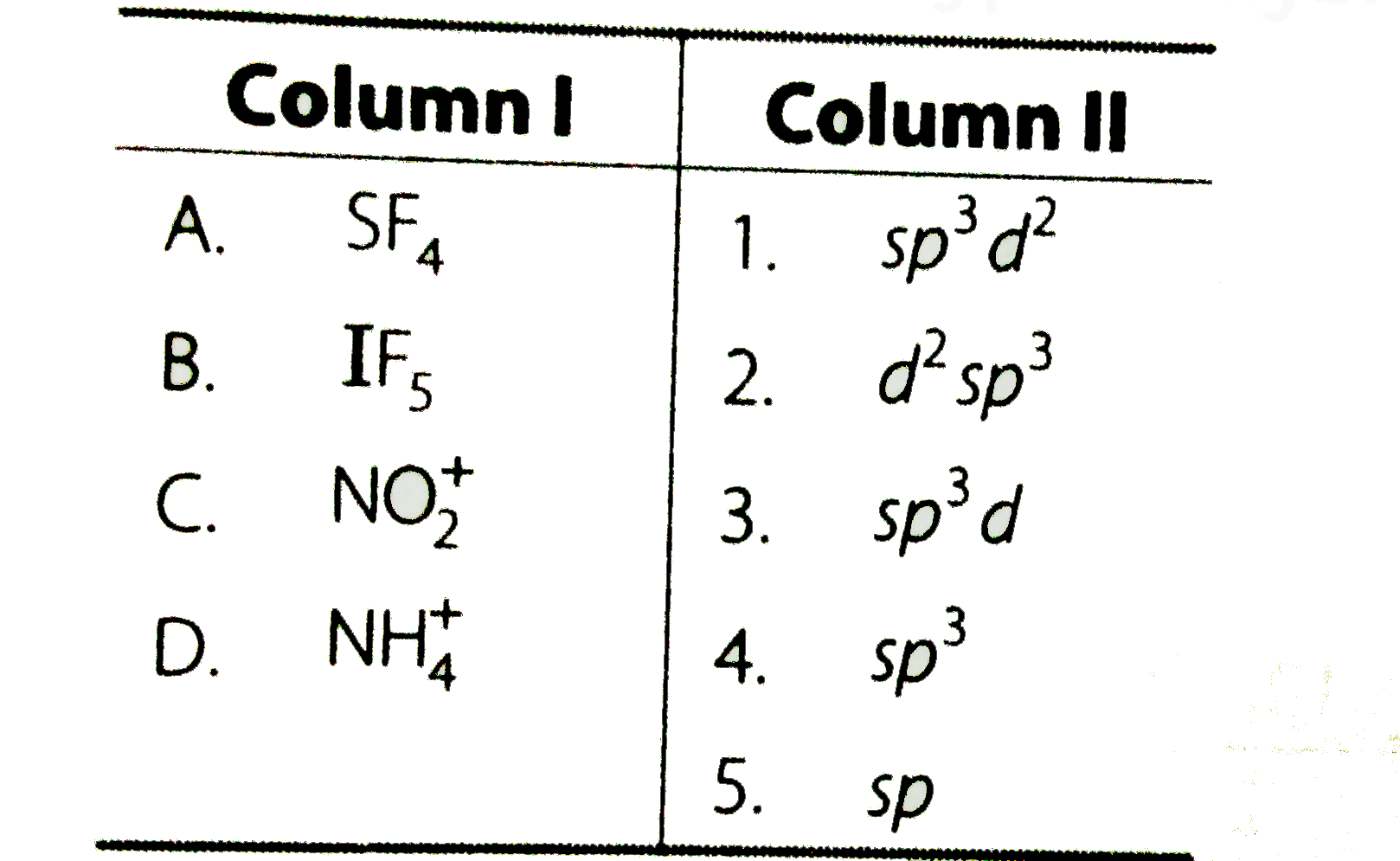Column IColumn II(A)Fe(OH)3(i)Ksp=s2(B)Ag2CrO4(ii)Ksp=27s4(C)CH3COOAg(iii)Ksp=108s5(D)Ca3(PO4)2(iv)Ksp=4s3
(A)→(III),(B)→(ii),(C)→(iii),(D)→(i)
(A)→(ii),(B)→(iv),(C)→(i),(D)→(iii)
(A)→(i),(B)→(iii),(C)→(ii),(D)→(iv)
(A)→(iv),(B)→(i),(C)→(iii),(D)→(ii)
The correct Answer is:B
(A)Fe(OH)3⇔Fe3+(S)+3OH−(3S),Ksp=27s4
(B)Ag2CrO4⇔2Ag+(2S)+(CrO4)2−(3S),Ksp=4s3
(C)CH3COOH⇔CH3COO−(S)+H+(S),Ksp=s2
(D)Ca3(PO4)2⇔3Ca2+(3S)+2(PO4)3−2(S),Ksp=108s5
Topper's Solved these Questions
- EQUILIBRIUMBOOK - DINESH PUBLICATIONCHAPTER - EQUILIBRIUMEXERCISE - Reason type questions
6 Videos
- ENVIRONMENTAL CHEMISTRYBOOK - DINESH PUBLICATIONCHAPTER - ENVIRONMENTAL CHEMISTRYEXERCISE - Integer Type Questions
4 Videos
- GENERAL PRINCIPLES AND PROCESSES OF ISOLATION OF ELEMENTSBOOK - DINESH PUBLICATIONCHAPTER - GENERAL PRINCIPLES AND PROCESSES OF ISOLATION OF ELEMENTSEXERCISE - UNIT TEST - 34
1 Videos
Similar Questions
Match the species in Column 1 with the type of hybrid orbitals in Column II.
Column IColumn II(a)SF4(i)sp3d2(b)lF5(ii)d2sp3(c)NO+2(iii)sp3d(d)NH+4(iv)sp3(v)sp
View SolutionMatch species given in Column I with the electronic configuration given in Column II.
Column IColumn II(a)cr(i)[Ar]3d84s0(b)Fe2+(ii)[Ar]3d104s1(c)Ni2+(iii)[Ar]3d64s0(d)Cu(iv)[Ar]3d54s1(v)[Ar]3d64s2
View Solution
Knowledge Check
Match the column I with column II and mark the appropriate choice.
Column IColumn II(A)Fe(OH)3(i)Ksp=s2(B)Ag2CrO4(ii)Ksp=27s4(C)CH3COOAg(iii)Ksp=108s5(D)Ca3(PO4)(iv)Ksp=4s3A(A)→(iii),(B)→(ii),(C)→(iv),(D)→(i)B(A)→(ii),(B)→(iv),(C)→(i),(D)→(iii)C(A)→(i),(B)→(iii),(C)→(ii),(D)→(iv)D(A)→(iv),(B)→(i),(C)→(iii),(D)→(ii)Match the complen ions given in column 1 with the hybridisation and number of unpaired electrons given in column 2 ad assign the correct code.
Column IColumn II(A)[Cr(H2O)6]3+(1)dsp2(B)[CO(CN)4]2−(2)sp3d2(C)[Ni(NH3)6]2+(3)d2sp3(D)[MnF6]4−(4)sp3(5)sp3d2AA-3, B-1, C-5, D-2BA-4, B-3, C-2, D-1CA-3, B-2, C-4, D-1DA-4, B-1, C-2, D-3Match the column I with column II and mark the appropriate choice.
Column IColumn II(A)C2H2(i)sp3d2 hybridisation(B)SF6(ii)sp3d3 hybridisation(C)SO2(iii)sp hybridisation(D)IF7(iv)sp2 hybridisationA(A)→(i),(B)→(iii),(C)→(ii),(D)→(iv)B(A)→(iii),(B)→(i),(C)→(iv),(D)→(ii)C(A)→(ii),(B)→(iii),(C)→(i),(D)→(iv)D(A)→(iv),(B)→(i),(C)→(iii),(D)→(ii)
Match the species given in Column I with hybridisation given in Column II.
Column-IColumn-IIA.Boron in[B(OH4)]−1.sp2B.Aluminium in[Al(H2O)6]3+2.sp3C.Boron in B2H63.sp3d2D.Carbon in buckminster fullereneE.Silicon in SiO4−4F.Germanium in[GeCl6]2−
View SolutionMatch the species in Column I with the type of hybrid orbitals in Column II.

View SolutionMatch the species in Column I with the type of hybrid orbitals in Column II.
Column IColumn II(i)BF3(a)sp3d(ii)H2O(b)sp2(iii)PCl5(c)sp3d2(iv)SF6(d)sp3
View SolutionMatch the rate law given in column I with the dimensions of rate constants given in column II and mark the appropriate choice.
Column IColumn II(A)Rate=k[NH3]0(i)molL−1s−1(B)Rate=k[H2O2][I−](ii)Lmol−1s−1(C)Rate=k[CH3CHO]3/2(iii)S−1(D)Rate=k[C5H5CI](iv)L1/2mol−1/2s−1
View SolutionMatch the compounds given in Column I with the hybridisation and shape given in Column II and mark the correct option.
Column IColumn II(A)XeF6(1)sp3d3−distorted octahedral(B)XeO3(2)sp3d2−square planar(C)XeOF4(3)sp3−pyramidal(D)XeF4(4)sp3d2−square pyramidal
View Solution
